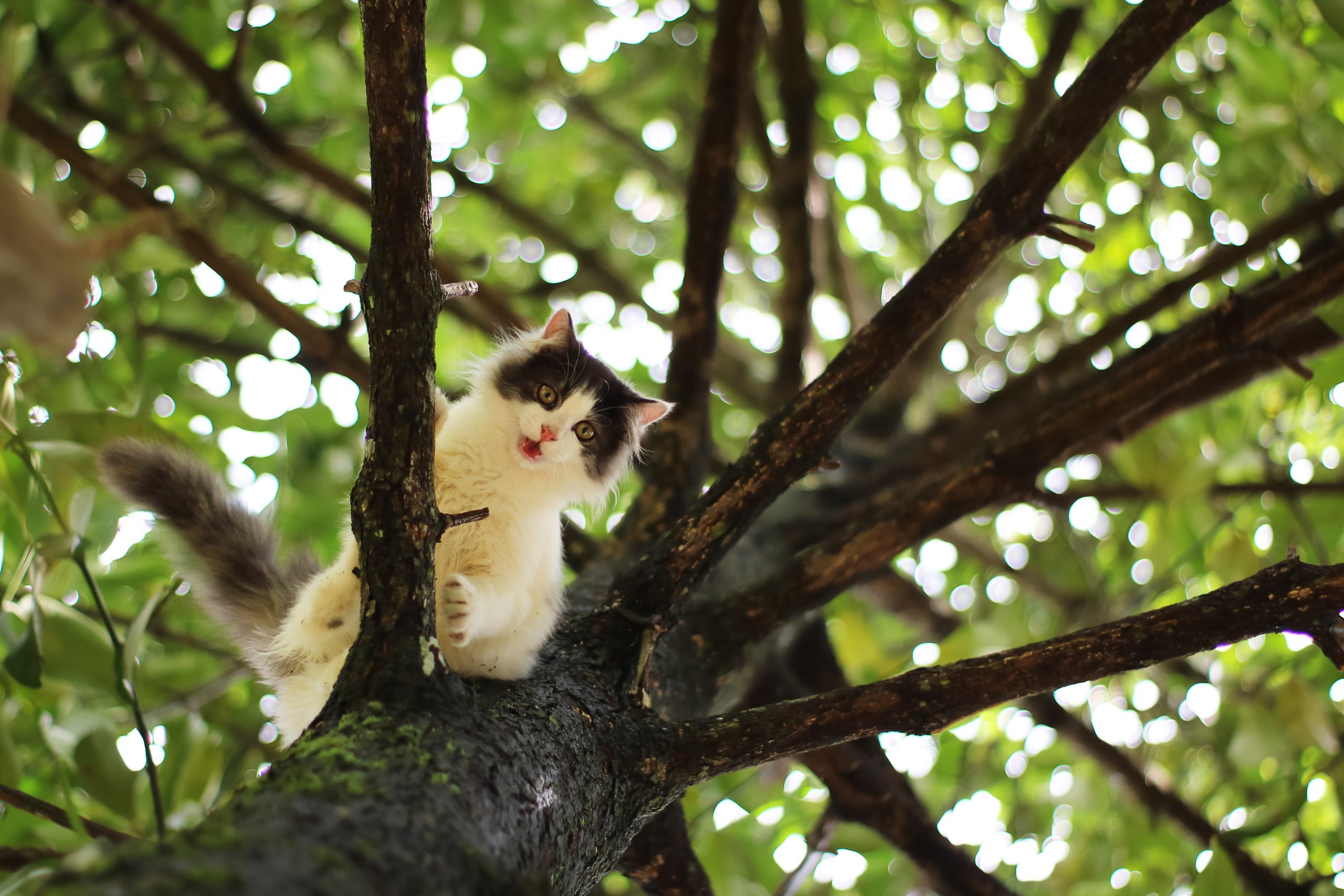Ralphie had gotten himself into a hairy spot, out on a limb. His family was desperate to reach him, but couldn’t.
Why not? Ralphie is a cat. The gray shorthair in Richfield, Ohio had discovered that climbing up a tree was easy, yet now he was unable to get down.
His family spent days chasing their tails, looking for help. Finally, they found Duane Hook, a tree climber who specializes in the high-tech fixing of feline misadventure .
Armed with ropes, harnesses, and a way with cats, Hook launched himself after Ralphie, who had clawed his way up a towering backyard maple and catwalked onto a spindly branch. Traversing expertly around limbs and leaves, Hook closed in on the fretting feline.
“It was like he was Tarzan in the tree,” recalls Connie Palmer, Ralphie’s owner, of Hook.
Finally, cats have found humans almost worthy of liberating them from perilous perches. Hook is one of many skilled tree climbers and arborists branching out into the crucial service of freeing cats from places cats aren’t meant to be.
There are enough of these experts that there is a worldwide directory . They deploy the whole kit and caboodle: honed climbing techniques, cutting-edge equipment, fluency in cat-speak and feline bribery (Churu cat treats are like “crack cocaine for cats,” Hook says). They call themselves cat rescuers—but they know better. For the most part the cat is in charge.
“Cats have this pride—they don’t want to admit they need help from this human,” says Hook, who makes cat calls through his volunteer service, “ Getmeowtahere Treetop Cat Rescue .” He delivered about 50 felines back to earth last year within driving distance of his home in the Columbus, Ohio area, and can tick off many tales, including one involving a 25-pounder called “Fat Cat.”
It isn’t clear how many cats take a sudden fancy to high-rise living. There is no official cat-alog of stuck-cat events, though a search online shows it is fairly commonplace. Many fire departments rescue cats. But they are also often busy helping humans, or may not always have high-enough equipment. So they, 911 dispatchers, and veterinarians frequently send distressed relatives to experienced tree climbers.
Climbing takes skill, but winning a cat’s trust can be the trickiest part, says Tom Otto, who rescued 726 cats last year and more than 75 so far this year with fellow arborist Shaun Sears in western Washington state, through their nonprofit Canopy Cat Rescue . “We try to build rapport with the cat,” Otto says.
He used his cat-whisperer bona fides recently with Bynx, a brown and white tabby up a Douglas fir. After more than 30 minutes of climbing, Otto encountered a big-eyed kitty with a frightened look. Otto played it cool and pretended not to pay attention to her. When he finally tried to pet her, she bolted even higher. They were at 185 feet—his highest ascent ever for a cat.
“I got the sense she was just really scared and just wanted some help,” he recalls. He moved up and softly pet the tip of her tail. This time, she turned and walked toward him on a twig, her paws and legs covered in resin. Otto scooped her up, whisked her into a net, and got a quick video on his phone. (Yes—because who doesn’t want to watch a video of a cat rescue?— climbers also, thankfully, litter their social-media accounts with cute cat content.)
Canopy Cat Rescue’s other recent clients include Bowser, Thumbelina, Roxy, Yeti and Bagel, who was stuck for nearly a week in a huge cedar tree.
“When folks call, we ask, ‘Hey, is your cat friendly?’” says Sears. “Does your cat run and hide when strangers come over? They’re going to act up a tree how they act on the ground.”
In the tree, the Canopy Cat Rescue arborists interpret vocalizations and body language. A high-pitched fast meow might be, hey, open to some help here , while Sears says a low growly one could mean “a kitty that is not super excited to get handled up in the tree.”
A cat happy for assistance might have its tail up like a flag, rub its head on a branch, or “make biscuits” with its paws, he adds. A skittish kitty might swish its tail or pull its ears back.
Can one scratch out a living as a cat rescuer? Many raise money or take donations rather than charge. Otto and Sears have also been given a dozen eggs, a plaster skull and a wooden statue of a cat with its tongue out.
Only a cat knows for sure why it scoots up a tree. Many are running from predators, Otto says. It is easy for cats to get up because they have front-facing claws, says Bob Reese, a cat rescuer in Huntsville, Ala. Getting down is harder.
A cat instinctively wants to descend head first, he says, “but they quickly learn that it doesn’t work.” He trained three of his cats to back down, using a harness and leash. Once a cat’s tail end points downward, says Reese, “gravity takes over and they shimmy backwards down the tree.”
It isn’t a hard rule, but most rescuers prefer to wait until a cat has been in a tree awhile before responding. “They haven’t submitted to their situation that they need help until they’ve been up there 24 hours,” Hook says. “They still think their options are better.” Owners can find that hard to digest. “I honestly do more counseling of humans than I do rescuing of cats.”
Hook, an engineer and packaging manager at a brewery, started rescuing cats in 2010. He already was a passionate tree climber, had cats and learned other climbers were saving felines from trees. “I thought, I have these skills and I’m good with cats.”
He kept at it, motivated by the challenge.
“These cats never choose to climb the trees I would choose to climb,” he says. “It tickles the problem-solving part of my brain.”
Ralphie had been stuck in the maple tree for five days by the time Hook arrived one evening after a 10-hour workday. With Ralphie meowing pitifully, Hook launched a line.
Secured with his harness and ropes and wearing a camera , he climbed up and through the canopy and inched along the branches.
By the time he reached Ralphie’s spot, the cat had crawled out toward the end of a thin branch. “C’mon kitty, kitty, kitty,” he called, offering tuna-flavored treats. Ralphie wasn’t buying it.
Using his climbing gear and a saw, Hook bent the branch and coaxed his target onto another limb. “Ralphie, why don’t you let me help you, buddy?” he pleaded, as the cat moved away again.
“OK Ralph, I’ve chased you all over this friggin’ tree,” Hook said, after a long pursuit. He pulled the limb with Ralphie toward him, and before the scared cat could escape, snatched him up and into a sack.
“Hey guys?” he called down to Ralphie’s owners. “The cat’s in the bag!”
Write to Betsy McKay at betsy.mckay@wsj.com



